Connecting a room thermostat to a gas boiler: thermostat installation guide
Saving electricity and gas, a stable comfortable temperature, a minimum of time spent on adjusting heating equipment - all these are not whims, but well-founded requirements for a properly organized heating process.
Therefore, connecting a room thermostat to a gas boiler, to ensure all of the above conditions, becomes an obvious necessity. We will talk about the principle of operation of the thermostat and the types of the device. Let's look at the differences in functionality of different models.
The article describes in detail the principles of connecting a temperature controller. Rules for installing different versions of the device are given. By following our recommendations, you can complete the installation yourself, without the help of heating engineers.
The content of the article:
Advantages of using a thermostat in heating
Gas heating is a benefit in itself and significantly increases the quality of life. But simplifying the management of gas heating equipment is an equally pressing issue.
Setting up and controlling the operation of a gas boiler can be done in two ways - manually or using a thermostat, which will automatically ensure a stable temperature regime.
Manual adjustment helps to set a specific temperature coolant in the system - when the temperature rises to the set values, the boiler turns off, when it decreases, it turns on. As a result, the temperature in the house is maintained at a certain level.
But as the temperature outside changes, the set mode turns out to be incorrect and you have to manually reprogram the heating device. Such manipulations are carried out throughout the heating season, and this is inconvenient.
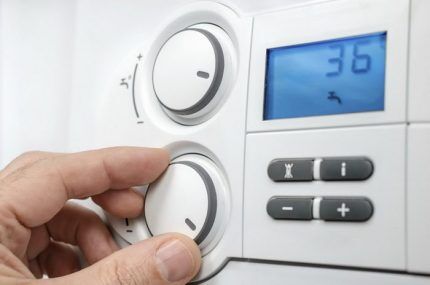
In addition, manual adjustment means the gas boiler operates in a constant on-off mode, with a working cycle period of about 10 minutes. This does not have the best effect on the operating time of the boiler.
Even in a system with manual adjustment, regardless of the operation of the heating function, constant circulation of the coolant is ensured using pumping equipment, which means excess electricity is consumed.
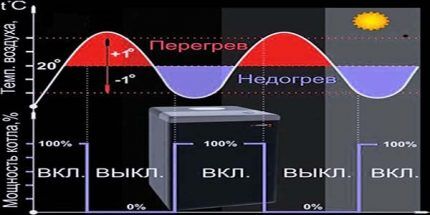
Automatic control, unlike manual control, turns off the circulation pump. Reacting to the temperature of the air in the room, and not the coolant in the heating circuit, thermostat for heating boiler maintains a stable temperature in the room.
As a result, the microclimate in the house is significantly improved, the frequency of boiler switching on is reduced, which means its service life increases.

Using a thermostat provides other benefits:
- the device sets the optimal/economical temperature mode depending on the time of day;
- solves the problems of gas boiler clocking - frequent switching on and off;
- facilitates operation and increases the reliability of the heating system.
These are just some of the obvious advantages common to all types of thermostats. The advantages of individual models can be studied in more detail immediately before purchase.
Types of thermostats for gas boilers
Thermostats can be divided into three main types: mechanical, electronic and electronic wireless.
Wired models cost less, but require cable laying - it is better to install a thermostat on a gas boiler before or during renovation work in the house. Wireless models are more expensive, more functional, and more convenient.
Selecting a thermostat to connect to gas heating system carried out taking into account the following basic criteria:
- functionality;
- adjustment accuracy;
- thermostat cost;
- ease of use and installation.
According to functionality they are distinguished:
- simple thermostats - help maintain the desired temperature in the house;
- wireless thermostats - have a transmitter unit that is placed in another room for more precise temperature control;
- programmable - allow you to set a stable temperature regime separately for day and night, program the operation of the heating system by day of the week, which significantly reduces fuel consumption;
- with hydrostat function - help control the humidity level in the room, reducing or increasing it according to the settings.
- With an additional floor sensor - the model is used, among other things, to regulate the coolant temperature in "warm floor" system.
- With an additional water heating sensor - the device is used both to regulate the temperature of hot water supply and to control the heating system.
Separately, it is necessary to say about programmers - thermostats that are more complex in terms of functionality, which are installed, among other things, to control climate systems in so-called smart homes.
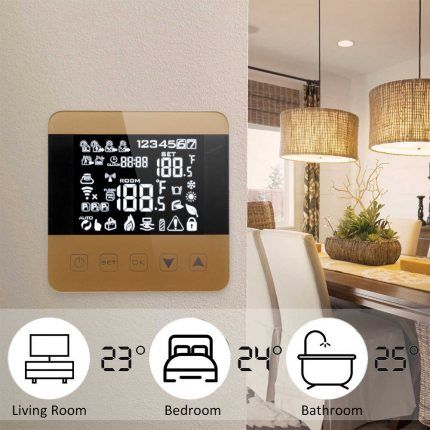
Programmers control the operation of not only heating and water heating equipment, but also air conditioners, pumps, and other devices. Some of them help to program individual temperature conditions for each day of the week with the ability to set from 1 to 6 fixed operating points.
General principles for connecting a thermostat
The method and diagrams for connecting the thermostat to the heating equipment itself can be found in the technical data sheet gas boiler. Modern equipment, regardless of manufacturer, requires connection points for the thermostat. The connection is made using the terminals on the boiler or the thermostat cable included in the delivery package.
If you are using a wireless thermostat, place the measuring unit only in a residential area. This may be the coldest room or the room where the largest number of people often gathers, the children's room.
It is not advisable to install a thermostat unit in the kitchen, hall or boiler room, where the temperature regime is unstable.
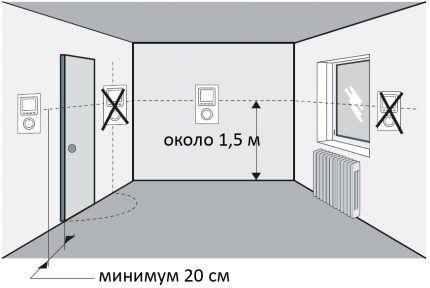
Connecting different types and models of thermostats may have their own characteristics; installation is carried out in accordance with the manufacturer's instructions, which are included with the device.
Recommendations include a comprehensive description of the regulator's operation, connection method and diagrams. Next, we will tell you how to properly connect a thermostat to a gas boiler and about the installation features of the most typical regulator models.
Connecting a mechanical thermostat
The mechanical type thermostat is distinguished by its reliability and simplicity of design, low cost, and long-term operation.
However, it supports only one temperature mode, which is set by changing the position of the handle on the temperature scale mark. Most thermostats operate in the temperature range from 10 to 30°C.
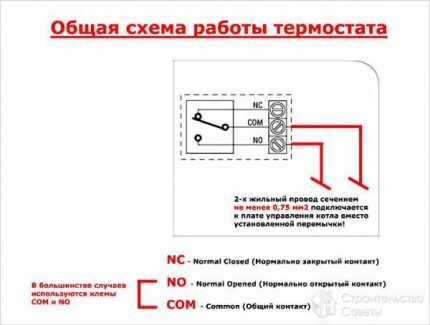
The mechanical thermostat has the simplest principle of operation and is activated through an opening and breaking circuit, which occurs using a bimetallic strip. The thermostat is connected to the boiler through the terminal box on the boiler control board.
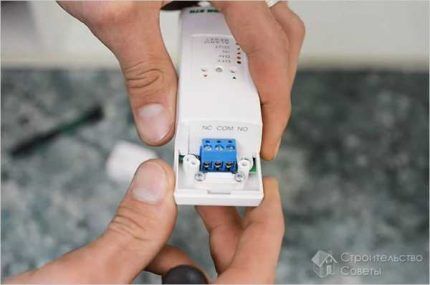
Installation of an electronic thermostat
The design of an electronic thermostat requires the presence of an electronic board that is responsible for controlling the device.
The control signal is potential - voltage is transmitted to the boiler input, which leads to the closing or opening of the contact.A voltage of 220 or 24 volts must be supplied to the thermostat.

An electronically controlled thermostat is used to organize the operation of complex climate systems. It will help in managing not only atmospheric or turbine gas boiler, but also a pump, air conditioner, servo drive in the heating system.
How to connect a wireless thermostat?
The wireless thermostat consists of two blocks, one of which is installed in a living room and acts as a transmitter. The second unit is mounted near the heating boiler and connected to its valve or controller.
Data transmission from one block to another is carried out over a radio channel. To control the device, the control unit is equipped with an LCD display and a small keyboard. To connect the thermostat, set the sensor address and install the unit at a point with a stable signal.

The main disadvantage of a wireless thermostat is that the remote unit is powered by batteries, which have a limited resource and therefore require frequent replacement. To ensure uninterrupted operation, the device is equipped with an alarm function that warns when the battery needs to be replaced.
Conclusions and useful video on the topic
How to connect a thermostat to a gas boiler:
Room thermostats for regulating the heating system:
Installing the device yourself should not cause any difficulties. But do not forget, when connecting the thermostat to a gas boiler, to study the instructions that come with the device and the technical documentation for the heating equipment.
Tell us about your own experience in choosing and connecting a thermostat to a gas boiler. Share useful information that may be useful to site visitors. Please leave comments in the block form below, ask questions, post photos on the topic of the article.



